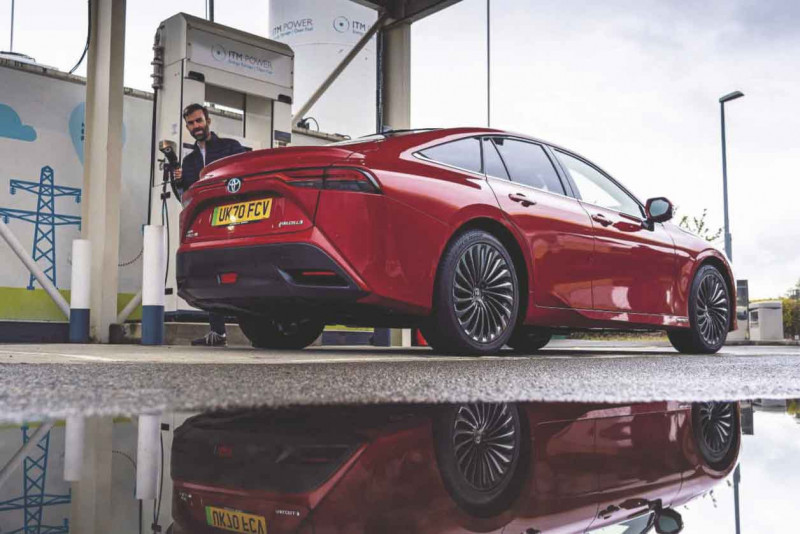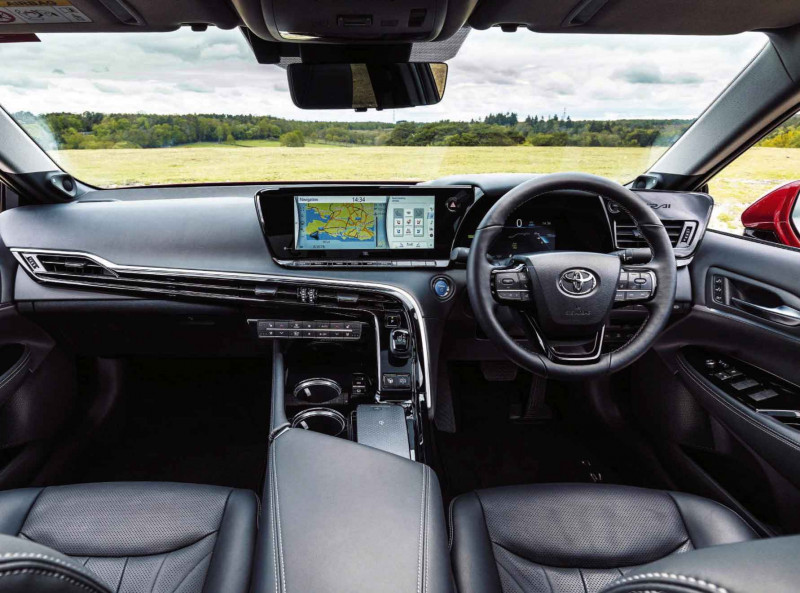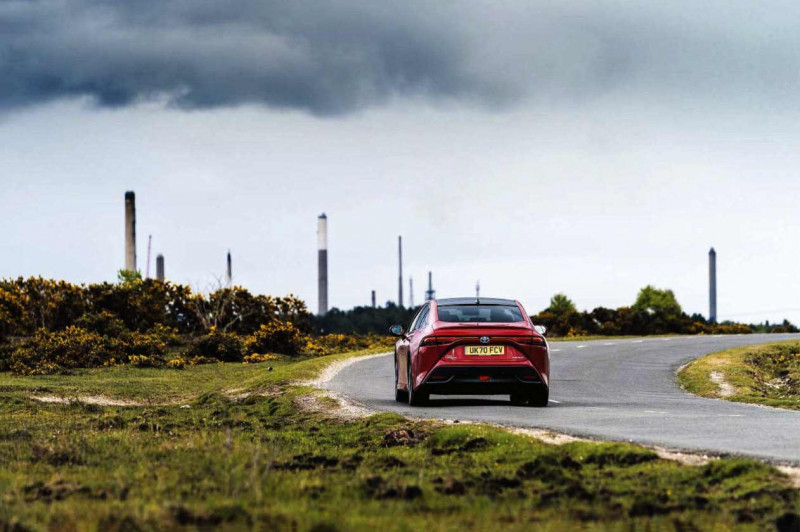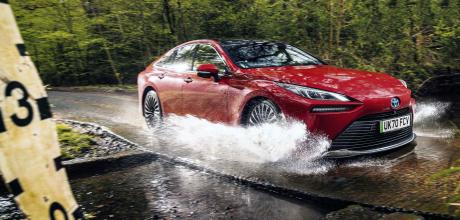300-mile test The pros and cons of hydrogen explored in the new 2022 Toyota Mirai Mk2
In search of the special source. Toyota’s thoroughly overhauled Mirai Mk2 is better in every way. But what of the hydrogen filling network?
The 300-mile test
NEW CAR MEETS REAL WORLD
The last one was a front-drive four-seater, whereas Mirai II: The HydroSequel seats five and drives the rear
Road tripping in a hydrogen fuel-cell car adds fresh piquancy to the range anxiety that blights all EVs. The UK’s H2 refuelling infrastructure is not so much patchy as bald, with just 11 facilities open to private motorists, concentrated around London, Swindon, Sheffield and Aberdeen. So when we were handed the keys to the new Toyota Mirai in Surrey for a 300-mile excursion we could have played it safe and headed up the M1, but instead headed due south. Why? Because we wanted a mini adventure, not 10 pages touring Britain’s industrial hotspots. We reckoned Crawley to Fawley would let us stress-test the fuel-cell tech, take in a mix of town and rural driving, and give us a dose of sea air. It would also take us past the UK’s biggest oil refinery. There and back should be a cinch, given Toyota’s bold claim of a 400-mile range, right?

You’ll be familiar with the Mirai: a gawky oddball early hydrogen adopter, more scientific test tube on wheels than a viable choice of executive car. The first one launched in 2014 and a trickle made their way to these shores, mostly piloted by fleets and public bodies with access to commercial hydrogen refuelling stations. Because if your journeys are urban, routine, predictable and within range of an H2 pump, why wouldn’t you want to drive an electric car that you can fill up in three minutes and that emits nothing ghastlier than water?
There are around 180 Mirais registered in Britain and the chances are you’ve yet to see one on the road. Now it’s the turn of the Mk2 to try to make an impression. And look at it! Gone are the angles so beloved of Japanese designers, replaced by a softer, more conservative aesthetic. You wouldn’t think it hailed from anywhere but the Far East, but you no longer need to browse the options list for a branded Toyota blindfold.

Ours looks smart in zingy Scarlet Flare pearlescent paint (a £925 option) and inside we find a resolutely normal, Japanese- flavoured cabin. If you’ve driven a Prius, you’ll feel at home here, echoing the hybrid’s stubby gearlever and graphics.
Considering the tech at play, it’s remarkably unremarkable to drive, and build quality is top-notch even if the materials tend to favour durability over opulence. Toyota has thrown the technological kitchen sink, work surface and larder at the latest Mirai and its fuel-cell tech is substantively improved from the Mk1. It sits on a new platform, dubbed GA-L by Toyota and called the platform from the Lexus LS by everyone else, and this is key to the advances made in the latest generation. The last one was a front-wheel-drive four-seater, whereas Mirai II: The HydroSequel seats five and drives the rear wheels. To continue the kitchen analogy, it’s quite a different kettle of fish. The fuel-cell stack shrinks to fit under the bonnet (previously it sat under the driver’s seat) and this new architecture liberates space for an extra hydrogen tank along the spine of the chassis, meaning there are now three storage bunkers onboard for greater capacity. Hydrogen is measured by weight, not volume, and the new Mirai will theoretically store 5.6 kilogrammes, up from 4.6kg for a 30 per cent improvement in claimed range. This should help keep range anxiety at bay.
The last one was a front-drive four-seater, whereas Mirai II: The HydroSequel seats five and drives the rear

We gather in Crawley at dawn, delivered by CAR’s reigning hot hatch of the year, the delectable Toyota GR Yaris, all finger-flicking manual gearchange, punchy 1.6 turbo and darty handling. Parked together, it’s difficult to process their shared parentage – but this zany product stretch is half the appeal of the Japanese car makers, isn’t it? We’re parked only a few feet from Toyota GB’s heritage collection, and it’s stuffed with goodies including original MR2s, a sizzling Lexus LF-A, monster-truck Hiluxes and an early RAV4. You never quite know what’s coming next from the world’s biggest car maker. The Mirai feels instantly more luxurious than the super-focused Yaris hot hatch, as we sink into the pillowy leather seats and adjust the driving position. My back began to ache on the trip down in the GR, but the fuel-cell car’s seats are pamper-perfect and no more twinges are felt for the ensuing 300 miles. Tap the start button and… nothing. The fuel cell is to all intents and purposes silent in operation and it’s only when you stand next to it that you notice a series of clicks and ticks, whooshes and wheezes coming from under the bonnet as systems are regulated to temperature. You half expect Doc Brown from Back to the Future to pop up.
Creeping away from the business park, you’d be forgiven for wondering what all the fuss is about. In operation the Mirai is just another EV, creeping silently at the squirt of the throttle. The emphasis is clearly on comfort and luxury. There are no Tesla histrionics here, just gentle acceleration; its 9.0sec 0-62mph time speaks volumes about its priorities.
It’s a large car but visibility is decent all round and we’re soon threading through Horsham town centre as we search for breakfast. The townsfolk of this genteel corner of Surrey scamper by with nary a look of wonder at the energetic marvels happening under the Mirai’s bonnet, too busy dodging rain showers to notice the small droplets of water being emitted from a waste pipe near the rear axle. There’s a prominent H2O button on the dashboard and we try without success to flush out gulps of water to capture in a glass for a liquid pic.
This is a shockingly affluent part of the commuter belt, a point rammed home when we’re charged 20 quid for two coffees and a couple of pastries, and it’s not long before we gather our belongings to hit the road in search of hydrogen.
It’s hard to believe there are only two refuelling stations in the whole of the south of England – one near Gatwick and the other at Cobham services on the M25. We pick the latter, as it’s en route to the M3 and our planned path to the south coast. Plumbing the destination into the Mirai’s sat-nav, we’re reminded of the gulf that exists between the best premium mapping (an honour still held by the Germans) and the current crop of Japanese navigation systems. The cartography, typography and overall user experience all seem a little odd if you’re used to European conventions. You’ll either get it or not, in the same way that you’ll instinctively prefer either Android or iOS. At least there are no Lexus-style joysticks or thumbpads here, just a more intuitive touchscreen.
Soon we’re jostling with lorries on the M25 and the saloon remains unusually hushed, even over those annoying, very British expansion joints. This is one of the most relaxing environments this side of a Rolls-Royce or Bentley, smoothing away the stresses inherent in our capital city’s orbital motorway.
We pull into Cobham services and tuck left to a large H2 station under its own canopy and nobody pays us the slightest attention as we embark on what must surely count as a module towards a GCSE in chemistry. It’s highly uneventful on one level: simply open the fuel flap, tug away a rubber dust cap to reveal a nozzle inside, on to which the fuel pump latches. Yes, yes – we had to read up on it first, and there were a couple of dummy runs, as I didn’t engage the catch correctly first time, but once attached it really is like filling with petrol until… hang on, isn’t the Mirai supposed to take onboard 5.6kg of the stuff? We’ve only managed to pump in 3.7 kilos at a cost, take note, of £44.52 – this hydrogen lark ain’t cheap.
Turns out that filling up isn’t as straightforward as the liquid fuels with which we’re familiar. Temperature, atmospheric pressure, the day of the week – all can affect how much fuel can be squeezed into those high-pressure tanks (and that’s assuming there’s no operator error and that the pump is working properly). The dash read-out reveals we have just 252 miles of range and our 300-mile ambition is looking in doubt. We have two things in our favour: we’ve already driven 46 miles pootling around the Horsham area and, secondly, that range creeps up to 276 when we flick the climate control off. But still, this is some way short of the 400-mile claim when brimmed, is it not?
Another reason to pussyfoot around greets us as we step off the forecourt to be greeted by an automotive unicorn: another Mirai waiting to fill up! Like London buses, turns out fuel-cell cars love a get-together. This white Mk1 looks like a gangster special, with four burly guys onboard. But rather than run away sharpish, we get chatting and it turns out to be an unmarked Met police car, stuffed with four coppers sporting stab vests and radio comms. They’re just popping in to top up with hydrogen and seem quite content in their silent, high-tech workhorse – even if I marvel at their unusual choice of response car and wonder what happens if they’re mid-pursuit and run out of gas.
We creep back on to the M25 and our H2 car joins the M3 southbound, rear-view-mirror surveillance suddenly taking on a new dimension as we realise that traffic cops really could be lurking in any vehicle you care to mention. With our range anxiety turned up to 11, speeding is not going to be a problem today: we set the radar cruise to 65mph and just waft down to the south coast, enjoying the excellent 14-speaker JBL stereo to the max, grateful it’s not a warm day requiring air-con. Even in this pouring rain, the Mirai tracks straight and true, and it remains entirely peaceful, soaking up the bumps and lumps and leaving me utterly refreshed.
Spearing west at Southampton, the landscape changes from M-way blandness to the grandeur of the New Forest. The Mirai is little fun on twisting back roads, but that’s not particularly down to its weight. At 1.9 tonnes, it’s about 300kg lighter than a comparable Tesla Model S. For that you can thank the fact that it doesn’t need huge batteries for its 300-ish-mile range. Toyota claims the latest-generation polymer fuel-cell stack, where hydrogen and oxygen are fed to create electricity, weighs just 52kg. Because it’s now tucked under the bonnet there’s a handy 50:50 weight distribution, so we don’t scare any ponies (or drivers) as we tackle some of the gently undulating lanes criss-crossing this national park. It doesn’t exactly tuck in or offer any meaningful feedback, but this is a five-metre-long luxury saloon and it’s built to waft.
The boot is very small for a big car, at just 321 litres, compromised by the need to package all the hydrogen hardware. And although the rear seats are perfectly usable, rear headroom is badly blunted by our top-spec Design Premium Pack’s sunroof, foot space is poor and I don’t fancy your chances of remaining friends with a centrally mounted fifth passenger. Up front it’s a different story, with space aplenty and all the bells and whistles you’d expect, including a natty head-up display and wireless phone charging.
Parked high up on a hillock, we spy the chimney stacks of Fawley oil refinery in the distance. It’s a strange juxtaposition, the industrial sprawl of modern energy rubbing shoulders with the rugged isolation of the New Forest, and I’m reminded how ExxonMobil is investing in a new hydrogen facility here to boost UK production of the gas that could revolutionise transport energy. It feels like fuel-cell cars will remain a novelty for a while at least, as the fledgling infrastructure couldn’t expand rapidly even if the demand were there. EV charging points, which are relatively easy to install, are fast becoming common.
But this journey has given me a chance to re-examine the dream. The joy of filling up in five minutes or less. The eerily silent electric operation. The fact we carry only a tiny ancillary lithium-ion 4.0Ah battery onboard to smooth over gaps in the fuel-cell delivery in short bursts – this really is a self-charging Toyota. It’s damned clever and I’m impressed by the advances made – to styling, engineering and driveability – compared with the Mirai Mk1, especially as the list price has plunged by a quarter to start at £49,995 (or £435 a month).
We turn around and head north. I’ve learned to trust the Mirai’s range meter; it is unerringly accurate. We’re driving sensibly, smoothly, sailing up the M3 in our very own hydrogen bubble, emitting nothing more than water vapour and smugness, and return to Crawley late at night with 21 miles to spare after a 303-mile round trip.
Fuel cells aren’t science fiction – they’re here and now. It feels like our political masters are backing conventional battery electric vehicles in a rush, before considering all the options. On today’s evidence, who’d bet against hydrogen having a place in the future energy matrix?
PLUS + Refined, relaxing EV that refuels in Minutes
MINUS — Cost still high; almost total lack of UK refuelling infrastructure; cramped rear cabin and boot.
ALTERNATIVES
Honda Clarity Honda’s take on the fuel-cell car. You’ll have to shop overseas as it’s not sold in the UK Hyundai Nexo Koreans are big on FCEV technology and Nexo melds H2 with SUV for a zeitgeisty look.
HOW TO REFUEL A HYDROGEN FUEL CELL
1 Find a hydrogen pump! According to UK H2 Mobility, there are only 11 hydrogen refuelling stations open to private motorists in the UK. Others are reserved for commercial vehicles and a few more are planned, but they’re so expensive to build that they’ll remain scarce for a while yet.
2 Swipe your card Our Mirai already had an account set up with ITM Power so we merely had to insert our access card, enter a PIN and we were set to refuel. Hydrogen isn’t that much cheaper than unleaded, at £12 per kilogramme.
3 Open fuel flap, doors to manual Pull a conventional fuel-filler lever in the cabin and the flap opens on the nearside to reveal a metal nozzle where you’d normally find a hole for petrol. Remove the rubber dust sleeve, guide the nozzle on and tug the lever to latch.
4 Watch as the pressure rises When the pump is attached, simply press a green illuminated button and refuelling starts automatically.We used the high-pressure 700-bar pump, not the less powerful 350-bar one alongside. Three minutes of clicking and whirring later and we’re full.
5 Having a gas We took on board 3.71kg of hydrogen at a cost of £44.52. One of the quirks of H2 refuelling is that you’ll squeeze a different amount of gas in depending on all the variables, including atmospheric pressure and temperature.
The temperature and atmospheric pressure affect how much fuel can be squeezed in.
Longer than a Camry, and almost as long as a Lexus LS.
‘I’m going in! Wish me luck.’ Instruction manual just out of shot. Much more like filling up with petrol than charging with electricity. Plenty of room in the front of the calm, comfortable cabin.
Pick-up
Mirai Mk1 made a statement: look what we can do. This Mk2 has shifted the emphasis significantly: look what you can have. But is the world ready for FCEV?
0 miles
We arrive at dawn at Toyota’s press garage in our GR Yaris long-term test car to collect the Mirai. This duo showcases the zany stretch of the Toyota family DNA.
2 miles
Okay, this car is B-I-G. At 4975mm from tip to tail, the Mirai’s as long as an Audi A7. It never feels daunting to drive, though: great visibility all-round helps make it manageable.
10 miles
First stop is Horsham, where the Mirai raises barely a glance from most observers. It’s just a big Toyota, albeit one that whooshes and clicks a lot as it creeps around town.
46 miles
We’ve started on a third of a tank, so it’s time to top up. The hydrogen refuelling process is refreshingly familiar to those raised on petrol and diesel. We pump in 3.7kg of H2.
73 miles
Amazing what you bump into at Cobham services: only another Mirai, one of 180 in the UK! The first-generation car looks ugly and boxy by comparison with our sleek new Mk2.
119 miles
The tyres are gargantuan 245/45 ZR20s, but the Mirai rides sweetly as we approach the New Forest: little thump and enough sidewall to absorb road scars.
186 miles
The further south we go, the drier it becomes. Praise be for the double sunroof, bathing the interior in a Hampshire glow. A fixed panel, it doesn’t tip or slide and is bad for rear headroom.
198 miles
We pass the UK’s biggest oil refinery at Fawley. ExxonMobil plans a hydrogen facility here, reflecting the driving nation’s gradual transition to cleaner fuels.
239 miles
Amazing how many parts feel familiar from other Toyotas: the stubby gearlever is pure Prius. You tap it into B every time you want extra regen braking.
282 miles
It’s getting late by the time we finish in the New Forest. We tiptoe back up the M3 northbound to conserve energy, while the auto-dipping headlights turn night into day.
Drop-off: 303 miles
Back to Toyota HQ and the GR Yaris. I love this fizzy hatch, but goodness it’s loud: it’s like we slid from a symphony concert to the front row of a Foo Fighters gig.
Mirai’s dynamic resemblance to GR Yaris: zero ‘Fuel Cell’ badging on side and rear is easy to miss; many assume it’s a BEV.
SOUND SELECTION Because the Mirai is so mechanically quiet in everyday driving, you can really hear the output from the JBL audio in exquisite detail. The sound quality is excellent
DOUBLE VISION The rear-view mirror flips between conventional mirror (as pictured) and digital camera mode. That’s useful for seeing through rear-seat passengers’ heads, if not much else.
BETTER. NOT GOOD What is it about Toyota/ Lexus touchscreens? To look at and to use this lags behind Euro norms, but at least there’s no Lexus-style joystick to compound the confusion.
NEED TO KNOW Digital instruments are easy to read and – crucially – make it simple to clock how efficiently you’re driving. Note also the 10-inch colour head-up display, standard on our Design Premium Pack model.
The temperature and atmospheric pressure affect how much fuel can be squeezed in
- PRICE £49,995 (Design PremiumPack tested£64,995)
- POWERTRAIN Polymer electrolyte fuel-cell, single-speed transmission, rear-wheel drive
- PERFORMANCE
- MAX POWER 180bhp
- MAX TORQUE 218lb ft
- 0-62MPH 9.0sec
- MAX SPEED 108mph
- WEIGHT 1950kg
- EFFICIENCY 0.89kg of hydrogen per 100km, 0g/km CO2
- ON SALE May 2021
- RATING 3/5
Our political masters are backing battery-electric vehicles in a rush, before considering all the options


